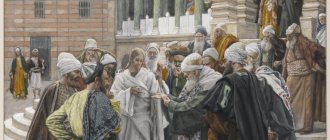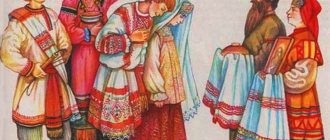Consolation of the Apostle Thomas
As you know, the Apostle Thomas did not participate in the burial of the Virgin Mary - at that time he was in the region of India and spread the Good News there. Only on the third day did he arrive in Jerusalem. Grieving and wanting to say goodbye to the Mother of God, he asked the apostles to open her tomb. Having opened it, the apostles were amazed, because the tomb turned out to be empty. Only the funeral shrouds remained in it, from which a wonderful fragrance emanated. “Kissing the funeral shroud remaining in the tomb with tears and reverence, they prayed to the Lord to reveal to them where the body of the Most Holy Theotokos had disappeared?” — writes Dmitry Rostovsky. In response to their question, the Mother of God appeared to the apostles at supper and greeted them with the words: “Rejoice! “For I am with you always.”
However, there is a legend that on the third day, that is, before this appearance, the Mother of God appeared to the Apostle Thomas through his prayer. To console him, she threw her belt to him from the sky. This tradition is depicted on Orthodox icons, and on the holy Mount Athos there is a 6th-century fresco depicting Thomas bringing the belt to the other disciples.
Empress Zoe and the Evil Spirit
The Golden Ark, in which the belt, revered as a great shrine, was enclosed for a long time, was first discovered at the end of the 9th - beginning of the 10th century during the reign of Emperor Leo the Wise. This was done with the permission of the patriarch for the emperor’s wife Zoe, who was overwhelmed by an unclean spirit. The emperor prayed to God for the healing of his wife. And a vision occurred that she would be cured of her weakness if the belt of the Virgin Mary was placed on her. When the ark was opened, it turned out that the belt, which had lain in it for almost ten centuries, had not decayed. The Patriarch applied the Belt to the sick empress, and she immediately got rid of the unclean spirit. As a token of gratitude to the Mother of God, Zoya embroidered the entire Belt with gold thread. After these events, Saint Euthymius, the emperor’s confessor and Patriarch of Constantinople, composed a Homily “in honor of the Most Blessed Virgin Mary, in remembrance of the miracle that occurred from Her Honorable Belt, by grace, mercy and love for mankind, Christ our God was born from Her.”
To the belt of the Virgin Mary
Estimated reading time: less than a minute.
My wife Katya and I visited the Belt of the Virgin Mary. Thank God, they kissed. We skipped the line with a pass. I regard the acquisition of the pass as a mercy, because Katya definitely would not have stood the line. We are such VIP officials - yeah. You can swear, but I consider the topic of passes to be completely far-fetched: those who say that this is a nightmare and all that have probably never stood in such a queue. Those who have stood at least once in a long-hour, but such a humanly warm queue to the shrine, know this unforgettable feeling of Involvement. Not ostentatious involvement, not hysterical football, not a rally, but quiet, confident, kind, and somehow truly eternal. Those who bypassed the queue - their joy was shorter, due to their physical weakness or - I do not argue - laziness. The queue is like an ice hole at Epiphany: it never hurts. So Ksyusha Sobchak can be forgiven - he doesn’t know what he’s saying.
To the sound of: just touching with your hand, not kissing (the ark had not yet been raised above your head), he kissed the dark strip sewn with silver threads, and - I write quite sincerely - I felt an unforced and some kind of childish touching joy - to the point of tears. Rejoicing and realizing that such ease and accessibility was somehow too, undeservedly simple, we decided to somehow get hooked inside the temple. Quietly, they entered to the right of the passage under a velvet rope, and amid shouts of “you can’t go there,” they kissed a piece of the Virgin’s robe. Then they backed up and stopped under the wall near a pile of boxes with belts. Just stand and pray. I really didn't want to leave.
A little later, volunteers came to pick up the boxes—volunteers helping to distribute icons and belts; I helped them carry a couple of boxes onto the street. Then the boss came and tried to identify us. I said that I was helping to carry the boxes, and Katya replaced the already green girl who was keeping written records on them. So we became volunteers. Then they forgot to relieve us, and we labored there for about five hours. That’s how it is in Rus': if they don’t expel you right away, they will definitely put you in a responsible position, and they will forget to replace you.
Then work began. We gave an incomplete box of belts (the full box contains 700 belts) to Alfa-Vympel. The box was sent to North Ossetia. Well, there - little by little - to various abbots and abbots - to Siberia, to the south, to the Moscow region. The main volume came from people leaving the church: sisters of mercy and volunteers distributed them at the exit. The boss complained: if only you knew how the nuns of the Martha and Mary Convent made these belts - with joy, with prayer, for days. And now they say that belts are already being sold at the Park of Culture for 500 rubles.
Later they brought another truck from Marfo-Mariinskaya, and the volunteers and I unloaded it. The priest came and blessed the boxes with the ark. And we - carefully and carefully - loaded them back, delivering them to cities and towns.
I remember the demoniacs - there were two of them in 5 hours. They shouted loudly.
We also talked to the nurse - he said everything was fine, their team didn’t have anything extraordinary. The cops didn't yell or hit anyone with their boots. The most tense cordon was the first one - at Kropotkinskaya, there people were really talking some kind of nonsense, and they were bothering the cops - one guard shouted, yes. Nervous profession.
The information in the top RBC regarding the reusable use of passes is a lie: at the fourth cordon they were cut with scissors, and at the fifth, at the entrance to the temple, they were taken away. Thus, it was no longer possible to pass through them twice.
Dorenko writes that the Russian Orthodox Church in this way demonstrates its power to Muslims. “It can withdraw a million and two...” Where to withdraw it? What exquisite insanity.
Late in the evening I was taken to the Cathedral of Christ the Savior museum. It's echoing and empty. The guard was lonely and bored. I wandered around and looked at photographs with the Patriarch.
Then, quite late in the evening, the athletes came - wrestlers, it seems. Very young, all Slavs. The guys are strong, ruddy and cheerful. They relieved us and we went home.
Belt division
In the 10th century, the Belt of the Virgin Mary was divided into parts, which eventually ended up in Bulgaria, Georgia (Zugdidi) and Cyprus (Trooditissa Monastery).
Helena, the niece of the Byzantine Emperor Romanos III Argir (Argyropoulo), received healing from the belt of the Virgin Mary. When in 1028, after the war with Georgia, the emperor made peace with her, he married Helen to the Georgian king Bagrat IV Kuropalates in order to seal the political alliance. With the permission of the emperor, the bride brought part of the Belt with her to a distant country. It is known that at the beginning of the 19th century, the ruler of Megrelia Nino, the daughter of the Georgian Tsar George XII, after accepting Russian citizenship, sent the shrine as a gift to the Russian Emperor Alexander I. The reaction of the Russian Tsar is surprising. Having decorated the ark with precious stones, he sent it back and ordered to build a stone church in Zugdidi to store the shrine. And to this day this part of the Belt is kept in the Cathedral of the Blachernae Icon of the Mother of God in a precious icon case.
Belt from Athos to Russia
Yesterday at the Cathedral of Christ the Savior, the chairman of the board of trustees of the St. Andrew the First-Called Foundation, Vladimir Yakunin, and Bishop Sergius of Solnechnogorsk announced a large-scale project.
From October 20 to November 23, one of the most significant Christian shrines will be transported to eleven cities of Russia: the Belt of the Blessed Virgin Mary.
This Belt was taken from Jerusalem to Constantinople in ancient times. It was believed that the shrine also brought military success, so the Byzantine emperors took part of the Belt with them on military campaigns. In one of them, the Bulgarians recaptured the shrine. Later the Belt was divided into parts, which eventually ended up in Bulgaria, Georgia and Cyprus. The Belt was presented to the Athos Vatopedi Monastery by the Serbian prince Lazar I (he died in the battle with the Turks on the Kosovo Field, we are revered as a holy great martyr), where the shrine has been kept for almost seven hundred years.
This monastery, reminiscent of an ancient fortress, stands on the northeastern coast of the Athos peninsula. In addition to the Belt of the Most Holy Theotokos, other relics are kept here: part of the Life-giving Cross of the Lord, particles of the relics of saints, apostles and great martyrs. The monks divided the Belt itself into two parts: one was placed in a cross, the other in an ark, which is taken out to the people during epidemics. The popularity of the shrine is only growing; today millions of Orthodox believe that the Belt is capable of healing even cancer patients. In addition to miracles of healing and military success, the belt of the Virgin Mary has become famous for another miracle, which, by the way, is especially relevant for Russia: it helps against infertility and contributes to the healthy bearing and successful birth of children.
Athonite monks make small belts from ordinary linen, consecrate them on the Belt and distribute them to believers. True, it is very difficult to get such a belt. The fact is that Vatopedi, like all other Athos monasteries, is closed to women. Pilgrims are forbidden to even set foot on this land; they can only observe the Holy Mountain from the water.
In this sense, bringing the shrine to Russia is not only a religiously significant event, but also a unique one.
The project was blessed by Patriarch Kirill of Moscow and All Rus': on October 20, the ark with the shrine will arrive in St. Petersburg, then the relic will be seen in Yekaterinburg, Norilsk, Vladivostok, Krasnoyarsk, Diveevo, Saransk, Samara, Rostov-on-Don, Kaliningrad. And finally, on November 19, the Belt will arrive in Moscow, where it will stay until November 23. After which the relic will return to Athos, where women, alas, cannot go.
In a month, thousands of people will be able to ask the Mother of God for help in childbearing and receive a consecrated healing belt.
By the way
In cities along the route of the ark, it will be possible to venerate the shrine not only in churches, but also in the Centers for the Protection of Motherhood and Childhood. All this is included in the program of the St. Andrew the First-Called Foundation and the Center for National Glory “The Sanctity of Motherhood.” The program and goals of the foundation’s activists are quite down-to-earth, aimed at protecting traditional family values. But people fighting to get the country out of the demographic crisis could use a little miracle today.
Schedule for bringing the belt of the Blessed Virgin Mary.
Vatopedi Monastery
The Vatopedi Monastery on Mount Athos in Greece contains a part of the belt of the Blessed Virgin Mary, which the Byzantine emperors took with them on military campaigns and which the Bulgarians once recaptured from the Byzantines. This is a gift from the Serbian prince Lazar Hrebelianovich, who ruled in the 14th century - the last independent ruler of Serbia. This prince is glorified among the saints of the Serbian Orthodox Church as a great martyr.
The history of the monastery is so closely intertwined with the history of the Belt that it can no longer be thought of separately from it. This is evidenced by the nickname “Agiazonites” (that is, “holy belts”), given to the Vatopedi monks on Athos.
The belt of the Virgin Mary was handed over by Archimandrite Ephraim, the rector of Vatopedi, to the rector of the St. Petersburg Theological Academy Ambrose Bishop of Gatchina and delivered to Russia. Initially, it was believed that the Belt of the Virgin Mary would visit 11 cities of Russia - St. Petersburg, Yekaterinburg, Norilsk, Vladivostok, Krasnoyarsk, Diveevo, Saransk, Samara, Rostov-on-Don, Kaliningrad and Moscow, but the huge number of people who wanted to touch the shrine forced this to be adjusted list. It included 3 more cities - Tyumen, Volgograd and Stavropol. The Belt will arrive in Moscow on November 19 and will be there in the Cathedral of Christ the Savior until the 23rd.
History of the Belt of the Virgin Mary
According to the legend that has reached us, the Mother of God wove a belt from camel hair herself and wore it until her dormition (death). This shrine and particles of the robe are the only things of the Virgin Mary that have survived to this day. There are two versions of how the Virgin Mary disposed of her belt. According to one, the Mother of God, after her death, appeared to the Apostle Thomas and gave him the belt as a consolation, because... He was the only one among the apostles who did not say goodbye to her, but appeared only on the third day after the burial and grieved greatly about it. Another version is taken from the Minology of Basil II and states that the belt was given by the Mother of God shortly before her death to two widows living in Jerusalem, and then the relic was passed on by the heirs from generation to generation. (approx. Minology of Basil II - an illustrated Byzantine manuscript in the genre of hagiographic literature, compiled in 979-989) In the 4th century, the emperor of the Eastern Roman Empire Arcadius delivered the belt of the Virgin to Constantinople to the Chalcopratian church. The relic was placed in a golden ark, sealed with the royal seal. In 458, Emperor Leo I moved it to the Blachernae Church. Until the end of the 12th century, the belt remained in Constantinople. In the 10th century, the belt of the Virgin Mary was divided into parts. The emperors of Byzantium took one of the parts of the shrine with them on military campaigns as a talisman. In 1185, during the struggle of Bulgaria for its independence from the Byzantine Empire, this part of the belt of the Virgin Mary was captured and ended up in Bulgaria, from where it later came to Serbia. In the 14th century, the Serbian prince Lazar I donated the belt along with a piece of the true Cross of the Lord to the Vatopedi monastery on Mount Athos, where it is kept to this day in the sanctuary of the main monastery cathedral.
The following claim to own the remaining parts of the belt of the Virgin Mary: - Blachernae Church in Zugdidi (Georgia); — Cathedral of Prato (Italy); — Trier Monastery (Germany); - Church “Umm Zunnar” (“Temple of the Belt of the Virgin Mary”) in Homs (Syria).
The celebration of the belt, called the “Position of the Honorable Belt of the Blessed Virgin Mary,” takes place on August 31 (old style), September 13 (new style).
Miracles of the Belt of the Virgin Mary
The wife of Basileus Leo VI the Wise (866-912), Zoya, was overwhelmed by an unclean spirit. The emperor asked the patriarch to open the ark with the holy relic. The belt turned out to be completely untouched by time. After it was applied to the patient, she completely got rid of her illness. As a token of gratitude to the Mother of God for the miracle, the empress embroidered the belt with gold thread, after which it was again enclosed in the ark and sealed.
In 1827, the founder of the Hilandar monastery, Father Savva, writes: “In Enos, the pestilence of the plague stopped with the grace of the Holy Belt of the Mother of God,” and then, after the holy Belt was transported to Didimotikhon, the following entry appears: “Here, as in Enos, the pestilence ceased by the grace of the holy Belt.”
At the end of the 19th century, the Turkish Sultan Abdul-Aziz turned to the monks of Vatopedi with a request for a belt in connection with the cholera epidemic that was raging in Constantinople. As soon as the ship with the shrine on board approached the pier of Constantinople, the epidemic raging in the city stopped, and the already sick people began to recover. Abdul Aziz was so amazed by this event that he ordered the belt to be brought to his palace so that he could honor it.
In 1894, residents of the city of Madita (Asia Minor) were plagued by locusts that destroyed standing crops. Desperate people asked the fathers of the Vatopedi monastery to provide them with the belt of the Virgin Mary to fight this evil. As soon as the ship with the Belt approached the harbor, a cloud of locusts rising from the fields darkened the sky and then, to the amazement of those present, rushed into the sea.
The miraculous belt of the Virgin Mary still performs many miracles. He is especially revered for the help he provides to women suffering from infertility. The Vatopedi monastery contains many letters in which women who have found the joy of motherhood enclose photographs of their babies born through this relic. “Agiazonites” (that is, “holy belts” - the nickname given to the Vatopedi monks) help infertile women without violating the rules of their male monastery (after all, visiting the monastery for women is strictly prohibited). On the ark, where the belt of the Virgin Mary is kept, they consecrate the ribbons and distribute them to the husbands of infertile couples. These improvised prayer belts are tied around the woman’s waist and worn until childbirth.
Address of the location of the belt of the Virgin Mary
Coordinates: N 40°18'51", E 24°12'40". Greece, Holy Mount Athos, Vatopedi monastery (in the northeast of the Athos peninsula, between the monasteries of Esphigmen and Pantokrator).
Vatopedi Monastery 63086 Karyes, Mount Athos Greece phone 8-10-30-23770-41488 (call hours from 09.00 to 13.00) fax 8-10-30-23770-41462
Belt of the Virgin Mary in Russia
As already written above, the miraculous belt will be in Moscow from November 19 to 23. A little practical advice based on the experience of those who have already touched the holy relic. Because There are a huge number of people who want to venerate the belt, the time of unity with this holy miracle is, to put it mildly, small, and the number of ribbons given out for consecration is also small, so it makes sense to stock up on a small ball of ribbon and consecrate it. Subsequently, it will not be difficult to cut this braid into the required number of belts. Those suffering who, due to various circumstances, will not be able to touch the belt of the Virgin Mary, should not despair. The monks of the Vatopedi Monastery, as mentioned earlier, consecrate ribbon belts on the holy belt. Upon request to the address of the monastery with a description of their problem, the monks send them by mail along with recommendations for use.
How to properly wear the belt of the Blessed Virgin Mary
Here are excerpts from the brochure-memoir issued with the belt: “...Believers gird themselves with this belt for a while, living by repentance, confession, prayer and communion of the Holy Mysteries. Spouses do the same, adding to this fasting and conjugal abstinence, if possible and by mutual agreement...” So nothing complicated - tie a belt, believe, live righteously and may you be rewarded according to your Faith.
Belt of the Virgin Mary - documentary film by Arkady Mamontov
Temple of the Belt of the Virgin Mary in Syria
In the city of Homs (ancient Emesa) there is a temple dedicated to the Belt of the Blessed Virgin Mary, the famous “Umm Zunnar”. According to the tradition of these places, the shrine was placed in a silver flower on a stand. In the center of the plant, surrounded by openwork petals under glass, lies a thin woolen belt made of camel hair and gold threads, about 60 centimeters long, twisted into a ring. According to legend, this is part of the belt of the Virgin Mary. It was found in 1953 after an ancient manuscript in Aramaic was discovered in a monastery in Mardin (modern Turkey). This manuscript indicated the place where half of the belt was kept, which Thomas took with him. Numerous healings also occur from this part of the shrine through the prayers of believers. In Umm Zunnar, next to the niche decorated with fresh flowers, where the Belt of the Virgin Mary is kept, there is a jug. Believers throw notes into it addressed to the Heavenly Intercessor.
Lots of belts
Orthodox believe that the copy from the miraculous icon is as holy as the original, that a stone from a holy place brought home can work a miracle according to the faith of the pilgrim. Likewise, the small belts made by the monks of the Vatopedi Monastery and consecrated on the belt of the Most Holy Theotokos have the same power as the belt itself - the power of faith of the person praying. People pass these belts on to each other, divide them into parts, and send them to different countries. Many write about healings not only from the “original”, but also through these simple belts and their parts sent to them. It is believed that in a pilgrimage the path is important, in line to the shrine - prayer (pre)standing in this line - that is, preparation, prayer and meeting with the shrine are one thing.
Divine measure and miracle of healing
The Belt of the Blessed Virgin Mary is not only a relic and a shrine, but also a standard, a divine measure that was used in the construction of cathedrals. For example, the proportions of the Annunciation Cathedral of the Diveyevo Monastery are determined by the belt of the Most Holy Theotokos, the length of which is 1 meter 20 cm, and are twenty belts wide (24 m), thirty long (36 m), fifty high (60 m). Twenty, thirty and fifty, added together, are equal to one hundred, that is, the monastic centenary, which is performed using the rosary. The belt became a measure for the construction of a number of Theotokos churches in Rus', including the Assumption Church in Rostov and the Assumption Church in Suzdal.
Many testimonies of miraculous healings from the belt of the Virgin Mary have been known since ancient times. Miracles continue in our time. Through people's prayers, their troubles of all kinds are resolved. But most of the evidence related to the belt comes from people who suffered from infertility and were cured (the flow of letters with photographs of newborns does not dry up at the Vatopedi Monastery) and from those who were healed from serious illnesses, including cancer.
In Russia, parts of the belt of the Virgin Mary are kept in the Serapion Chambers of the Trinity-Sergius Lavra, in the Kazan Cathedral in St. Petersburg and in the Church of Elijah the Prophet in Obydensky Lane in Moscow, where you can venerate them at any time.
The power of the shrine is in great love
Why do we worship shrines
Many Christian shrines exist in this world, and pilgrims come and go to them, coming from all over the Earth... What are we looking for, what do we want from shrines? Yes - a miracle, yes - healing from physical and mental illnesses, yes - benefits for yourself and your loved ones. But still, the most important thing that we receive by touching shrines is not of a material nature. The power of any shrine lies in the fact that it contains a huge charge of Divine love. No, the shrine is not an amulet or some kind of talisman, and not a magic wand that works miracles and fulfills wishes. And you shouldn’t expect a miracle for someone who doesn’t open their heart to God. But touching the shrine, even closed, hardened hearts suddenly open, thaw, and God enters these hearts, overshadowing them with his great love.
God is always good, God is always full of love - for everyone and everyone, no matter what! Another thing is that not every person is ready to open the door in his heart to meet God and let God into his life. Shrines help us, first of all, because something changes inside us when we come to the shrines. God's love bursts into our open hearts - and the strength of this love is enough for us to overcome our illnesses and cope with troubles. That's when the real miracle happens. And this miracle is created in ourselves, in our soul - not by the shrine as such, but with its help.
Many people, touching a shrine, feel how the love and grace of God enters them. And the power of this love and grace is almost as tangible, material, as those material things that we are accustomed to seeing with our eyes and considering the only reality. Shrines show us that there is another reality - a spiritual one. And only he can become happy and change his life for the better, who has accepted this spiritual reality and put it in first place, and not material goods.
The power of the shrine is not that it is a material object, but that it contains living love, allowing each of us to feel: both the Most Holy Virgin and Her Son - here they are, next to us, have never left us, always ready to lend a helping hand to us. You touch the shrine and the canonized images come to life. And we understand: all this is real, we live on the same Earth on which the Mother of God walked, we breathe the same air, and now we touch the same things that Her hands touched... And we get a feeling of the living presence of God, and we touch His strength, and we receive help and support, and we feel how light and grace enter our hearts.
Touching the shrines, filled with the enormous power of grace, light and love that is inherent in them, you begin to understand what real faith is: not following memorized rituals, not just the habit of praying and making the sign of the cross - but a living feeling of a deep heartfelt connection between us , mere mortals, and a loving Heavenly Father, as well as all our intercessors and patrons who live in Heaven, among whom the First is Jesus, and the First after the First is the Mother of God. When you feel their living presence, when you feel their living love, then the prayers sound different, because we feel with all our souls: they will hear us, they will help us, they will overshadow us with love and grace, and they will invisibly extend a helping hand.
It is a well-known truth: it is given to us according to our faith. By faith and love. And if we approach the shrine with sincere faith and love, then it will help us, take us away from trouble, guide us on the right path, and bestow us with Divine strength, which can cope with any illnesses and adversity.
Those who love the Mother of God with all their soul, who pray to her tirelessly, understand me: it is for them that the Athos shrine, the Belt of the Most Holy Theotokos, is now revealing all its miraculous power to the fullest - and miracles are happening in millions of Russian families.
The main miracles for which the Belt of the Blessed Virgin Mary became famous:
♦ healing from infertility;
♦ getting rid of problems during pregnancy and childbirth;
♦ assistance in the birth of a healthy child;
♦ healing from all diseases, including cancer;
♦ military success, help in the fight for justice.
But you can pray over the shrine for any other help - in your personal life, family affairs, solving everyday, material problems, etc. There are no special rules on how to express respect for the shrine: you can touch it with your hand, kiss, and even just standing or walking nearby. Important: it is not the Belt that is asked for help, but the Most Holy Theotokos.
Pray to the Mother of God, love her! And a new, amazing world full of light and love will open to you.







